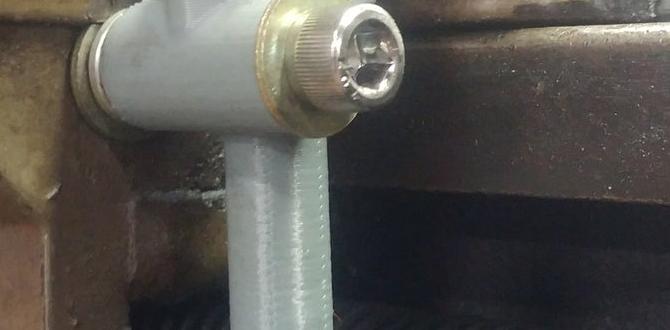A 1/8 inch stub carbide end mill is crucial and often the best choice for cutting fiberglass because its stub length prevents chatter and breakage while its carbide material handles the abrasive nature of the composite effectively, leading to clean cuts and prolonged tool life.
Working with fiberglass can be tricky. It’s tough, it’s abrasive, and cutting it cleanly often feels like a puzzle. Many DIYers and hobbyists run into frustration when their mills struggle, leaving jagged edges or worse, breaking their cutting tools. If you’ve ever experienced this, you’re not alone. The good news is, the right tool can make all the difference. Today, we’re diving into why a specific type of end mill—the 1/8 inch stub carbide end mill—is your secret weapon for tackling fiberglass projects with confidence. We’ll break down what makes it so special and how to use it for the best results. Get ready to cut fiberglass like a pro!
Why Fiberglass is a Tough Material for Machining
Fiberglass, or glass-reinforced plastic (GRP), is a composite material. It’s made of a polymer matrix reinforced with glass fibers. This combination gives it impressive strength, durability, and resistance to corrosion, making it popular in everything from boat building and automotive parts to aerospace and construction. However, these same properties make it a challenging material to machine.
The glass fibers are extremely abrasive. Imagine tiny shards of glass constantly rubbing against your cutting tool. This high abrasion rate can quickly dull or even destroy standard cutting tools designed for softer materials like wood or even some metals. The resin that binds the glass fibers can also be “gummy” or melt under friction, leading to unpredictable chip formation and poor surface finish.
Furthermore, fiberglass dust created during machining is a significant health hazard. It’s important to always use appropriate personal protective equipment (PPE) and dust collection systems when working with this material.
What is an End Mill?
Before we focus on the specific 1/8 inch stub carbide end mill, let’s quickly cover what an end mill is. An end mill is a type of rotary cutting tool used in milling operations. Unlike a drill bit, which is primarily designed for making holes, an end mill can move in several directions, including horizontally, vertically, and radially. This versatility makes them invaluable for creating slots, pockets, profiles, and performing contouring operations on CNC machines or manual milling machines.
End mills come in various shapes, sizes, numbers of flutes (the helical grooves on the cutting edge), and materials. The choice of end mill depends heavily on the material being cut and the desired outcome.
Introducing the 1/8 Inch Stub Carbide End Mill for Fiberglass
When it comes to machining fiberglass, not all end mills are created equal. The 1/8 inch stub carbide end mill stands out for several key reasons:
1. Carbide Material: The Durability Champion
Carbide, specifically tungsten carbide, is an extremely hard and dense material formed by combining tungsten and carbon. Its hardness is second only to diamond. Why is this critical for fiberglass?
- Abrasion Resistance: As mentioned, fiberglass is highly abrasive. Carbide’s superior hardness allows it to resist this wear far better than High-Speed Steel (HSS) or other tool materials. This means your tool stays sharp longer, leading to cleaner cuts and less frustration.
- Heat Resistance: Machining generates heat. Carbide can withstand much higher temperatures than HSS without losing its temper (hardness). This is crucial when cutting composites, as excessive heat can melt the resin binder, causing chip welding and a poor surface finish.
- Tool Longevity: Because carbide is so hard and heat-resistant, tools made from it last significantly longer when used in abrasive or high-temperature applications like cutting fiberglass.
2. The “Stub” Length Advantage
The term “stub” refers to the tool’s length. A stub-length end mill is shorter than a standard or long-reach end mill. This shorter flute length is not just a design choice; it offers tangible benefits when cutting fiberglass:
- Increased Rigidity: A shorter tool is inherently stiffer. This rigidity is vital because it significantly reduces tool deflection and vibration (chatter). Chatter is a common problem when milling, leading to rough surfaces and potentially broken tools, especially with materials like fiberglass.
- Reduced Chatter: Chatter occurs when the cutting edge is not making a consistent cut, leading to a vibration that degrades the surface finish and stresses the tool. The stub length minimizes the unsupported length of the cutting flutes, making the tool much more resistant to chatter when engaging with the tough fiberglass.
- Better for Shallow Cuts: For many fiberglass applications, especially on CNC machines, you might be making relatively shallow passes. A stub length is perfectly suited for this, offering maximum stability for the depth of cut required.
3. The 1/8 Inch Diameter
The 1/8 inch (3.175 mm) diameter is a common size for fine detail work on CNC routers and smaller milling machines. It offers a good balance for:
- Detail Work: It’s small enough to cut intricate shapes and achieve good corner radii.
- Material Removal Rate: While not designed for heavy material hogging, it can efficiently remove material in fiberglass when used with appropriate feed rates and speeds.
- Cost: 1/8 inch end mills are often more affordable than larger diameter tools, and carbide versions provide excellent value due to their longevity.
Key Specifications to Look For
When purchasing a 1/8 inch stub carbide end mill for fiberglass, pay attention to these specifications:
| Specification | Description |
|---|---|
| Material | Tungsten Carbide (Solid Carbide) |
| Diameter | 1/8 inch (3.175 mm) |
| Cutting Length | Stub length (shorter than standard, typically 1/4″ to 1/2″) |
| Shank Diameter | Often 1/8 inch or 1/4 inch (ensure it fits your collet/tool holder) |
| Number of Flutes | 2 or 3 flutes are common and work well for composites. More flutes can sometimes lead to overheating or chip packing in composites. A 2-flute is often preferred for better chip evacuation. |
| Coating | A coating like ZrN (Zirconium Nitride) or AlTiN (Aluminum Titanium Nitride) can further enhance performance by reducing friction and increasing heat resistance, though it’s not always essential for hobbyist use. |
| Helix Angle | A higher helix angle (e.g., 30-45 degrees) can help lift chips and reduce the cutting force, which is beneficial for composites. |
Pro Tip: Look for end mills specifically designed for composites or plastics. They often have optimized geometries and edge preparations for these challenging materials.
Step-by-Step Guide: Using Your 1/8 Inch Stub Carbide End Mill on Fiberglass
Here’s how to get the best results when milling fiberglass with your 1/8 inch stub carbide end mill. Safety first – always wear safety glasses, a dust mask (rated for fine particles), and hearing protection.
Step 1: Machine and Material Preparation
- Secure Your Workpiece: Ensure the fiberglass panel or part is firmly secured to your milling machine’s table or jig. Clamps, double-sided tape rated for machining, or a vacuum table can be used. Any movement during cutting will ruin the cut and potentially damage your tool or machine.
- Dust Collection: Set up an effective dust extraction system. A shop vac with a fine dust filter is essential to capture the hazardous fiberglass dust. Position the vacuum nozzle as close to the cutting area as possible.
- Coolant/Lubrication (Optional but Recommended): For fiberglass, a light mist of water or a specialized cutting fluid can help keep the cutting edge cool and reduce dust. However, ensure your machine is compatible with wet machining. Alternatively, dry machining with excellent dust collection is common.
Step 2: Setting Up Your CNC or Manual Mill
- Install the End Mill: Securely install the 1/8 inch stub carbide end mill into a clean collet that matches the shank diameter. Tighten it properly in your machine’s spindle.
- Set Zero/Origin: Accurately set your X, Y, and Z zero points. For Z zero, it’s common to touch off on the top surface of the fiberglass.
- Initial Depth of Cut: Start with a conservative depth of cut. For fiberglass, a common starting point for a 1/8 inch end mill might be 0.010 to 0.020 inches (0.25 to 0.5 mm) per pass. You can gradually increase this if the machine and tool are performing well.
Step 3: Determining Cutting Speeds and Feeds
This is crucial for success. Cutting speeds (how fast the tool spins, RPM) and feed rates (how fast the tool moves through the material, inches per minute or millimeters per minute) need to be optimized for fiberglass and carbide.
General guidelines for 1/8 inch stub carbide end mills in fiberglass:
- Spindle Speed (RPM): Start in the range of 10,000 – 20,000 RPM. Higher RPMs can be beneficial for composites to create more heat in the chip rather than the workpiece, but it depends on your machine’s capabilities.
- Feed Rate (IPM/MM/min): This is highly dependent on RPM and depth of cut. A good starting point might be 10-25 IPM (250-635 mm/min) for a depth of 0.010″. You want to hear a consistent, crisp cutting sound, not a squeal or a grinding noise.
Example Calculation (Conceptual): If your end mill manufacturer suggests a Surface Feet per Minute (SFM) of 300 for carbide in a similar composite, and you have a 1/8″ diameter tool (0.125″):
RPM = (SFM 3.4) / Diameter (inches)
RPM = (300 3.4) / 0.125 = 8160 RPM
This is a very basic calculation. Actual recommended speeds and feeds can be found in manufacturer datasheets or online calculators. It’s always best to start conservatively and adjust.
For the most precise recommendations, always consult the end mill manufacturer’s specifications. Websites like CarbideProcess.com offer selection guides that can be helpful.
Step 4: Making the Cut
- Engage the Spindle: Bring the spindle up to the desired RPM.
- Plunge (if applicable): If plunging into the material, use a slow plunge rate (e.g., 5-10 IPM). Carbide is brittle, so plunging too fast can break the tool. Using a 2-flute end mill can help with chip evacuation during plunging.
- Begin Milling: Slowly feed the end mill into the fiberglass at your set feed rate. Listen to the sound of the cut. If it’s squealing, you might be going too fast or cutting too deep. If it sounds like it’s struggling or grinding, you might be going too slow, or the depth of cut is too high.
- Step Through the Material: Make multiple shallow passes rather than one deep cut. This reduces the load on the tool and the machine, leading to a cleaner finish.
- Chip Evacuation: Monitor chip evacuation. If chips are piling up or looking melted, your feed rate might be too slow, or your RPM is too high, or you need better dust collection/cooling.
Step 5: Finishing Touches and Inspection
- Final Pass: For critical applications, consider a final “clean-up” pass at a very shallow depth (e.g., 0.005″) and a slightly slower feed rate to achieve the smoothest possible surface finish.
- Remove the Part: Once the milling is complete, turn off the spindle and carefully remove the cut fiberglass piece.
- Inspect: Check the cut edges for smoothness, accuracy, and any signs of melting or delamination.
- Clean Up: Thoroughly clean your machine and workspace to remove all fiberglass dust.
Benefits of Using a 1/8 Inch Stub Carbide End Mill Spreadsheet
To help you keep track of optimal settings and your results, consider creating a simple spreadsheet. This will be a valuable resource for future projects.
| Project Description | Fiberglass Type | End Mill Specs (Dia, Length, Flutes) | RPM | Feed Rate (IPM) | Depth of Cut (in) | Notes (Surface Finish, Tool Wear) |
|---|---|---|---|---|---|---|
| Prototype Enclosure Side Panel | G10 (Epoxy/Glass) | 1/8″ Stub, 2 Flute Carbide | 15000 | 20 | 0.015 | Clean, minimal dust. Tool appears sharp. |
| Custom Drone Frame Component | Bidirectional Woven Glass | 1/8″ Stub, 3 Flute Carbide | 12000 | 15 | 0.010 | Slight chatter on thicker sections, improved with slower feed. |
| Model Boat Hull Section | Chopped Strand Mat/Polyester | 1/8″ Stub, 2 Flute Carbide | 18000 | 25 | 0.020 | Good chip evacuation, smooth finish. |
This kind of record-keeping (often referred to as setting up a “tool crib card” in larger shops) allows you to quickly recall what worked best for specific materials and operations.
Alternatives and When to Consider Them
While the 1/8 inch stub carbide end mill is highly recommended, other options exist, though they often come with compromises:
- Standard Length Carbide End Mills: If a stub length isn’t available, a standard 1/8 inch carbide end mill can work, but you’ll need to be extra vigilant about minimizing chatter. Use lighter depths of cut and slower feed rates. The increased flexivity makes them more prone to vibration.
- High-Speed Steel (HSS) End Mills: HSS is less expensive but significantly less hard and heat-resistant than carbide. For fiberglass, HSS will dull very quickly, leading to poor cuts and increased heat. They are generally not recommended for extended fiberglass machining.
- Large Diameter End Mills: For faster material removal on less detailed parts, larger diameter end mills (e.g., 1/4″ or 1/2″) might be considered. However, for a 1/8″ shank, you’d typically be using a 1/8″ diameter tool anyway. If you have the machine rigidity, a larger diameter stub end mill can sometimes perform better for bulk material removal than a very small one, but that’s beyond the scope of small detail work.
- Specialized Composite End Mills: Some manufacturers offer end mills with specific geometries (e.g., compression or O-flute bits) designed for composites. These can offer superior finishes but are often more expensive. An O-flute bit has no helix, designed to cut without lifting or pushing material, which is great for preventing delamination in some composites. However, they require precise chipload management.
For most beginner and intermediate users looking for a reliable, cost-effective solution for general fiberglass milling, the 1/8 inch stub carbide end mill is the clear winner.
Common Issues and Troubleshooting
Even with the right tool, you might encounter issues. Here’s how to troubleshoot:
- Poor Surface Finish (Roughness/Chatter):
- Cause: Tool deflection, insufficient rigidity, incorrect speeds/feeds, worn tool.
- Solution: Reduce depth of cut, slow down feed rate slightly, ensure your collet is clean and tight, check if the tool is bent or worn, ensure the workpiece is absolutely secure. Try a different end mill.
- Melting or Gumming of Resin:
- Cause: Tool is dull, cutting too fast (feed rate too slow for RPM), or not enough cooling.
- Solution: Increase feed rate, decrease RPM slightly, use a cutting fluid or mist, or ensure your dust collection is







